Tag: wine
You Never Forget Your First Crush
Scott Elliff of DuCard Vineyards once told me that harvest was a joyous time, the culmination of a year’s hard labor tending the vines. And on September 21, after four years of planning, preparation, and hard work, we experienced that joy in our own vineyard, picking grapes from the vines we had planted with our own hands and nurtured like our own children. If I’m at this ten years from now, I’m sure I’ll still find joy in the harvest, but I doubt that it will be anything like the euphoria I felt as we picked those first Cab Franc grapes this year.
To recap a bit, the Vineyard Goddess and I began this adventure some four years ago. We took classes on viticulture and enology at Piedmont Virginia Community College, did lots of research on our own, debated which clones and which rootstocks to order, and finally planted our vineyard in the (very) early spring of 2012. Since then, we’ve invested a lot of sweat, a couple of tears and even a little blood (I snipped my finger with the pruning snips during the harvest) in bringing those vines to the point where they were ready to produce a crop of grapes worthy of picking.
And, oh my God – did those vines ever produce!
The Cab Franc and the Petit Verdot were absolutely magnificent: nearly perfect fruit that proved irresistible to the bees that laid siege to those rows of vines. The Merlot, for whatever reason, fell behind. I had thought we’d pick the Merlot first among the reds, and by all rights we should have. But after accumulating sugar at a rapid pace, the Merlot vines just shut down. We picked them October 5, and I’m hoping for the best.
The Viognier was disappointing. Virginia-grown Viognier makes a wonderful wine, but it’s hard to grow. For some reason it’s subject to something called primary bud abortion, and I guess our vines experienced that phenomenon, because the Viognier was the least fruitful of all our varieties. The grapes looked lovely, but I had expected about 100 pounds or so, and we got about 20. Other vineyards around the Commonwealth had the same experience, though on a totally different scale (the difference between tons and tens of pounds).
The last of our varietals is Petit Manseng, and those grapes looked beautiful when we harvested them two weekends ago. We want to make a desert wine from them, and so we let them hang a bit longer than we might have. We had hoped they would accumulate a little more sugar and lose a little more acid. If we had known we were in for some pretty significant rain the week prior, we might have chosen differently, but weekend vintners like us have to make some tough decisions and then live with them. As it turned out, we didn’t get the extra sugar or the lower acidity. We’ll work with it.
But getting back to where I started, there are some things you never forget. I can still remember the first crushes of my life – the first time I saw the Vineyard Goddess in the newsroom of our college newspaper, the first book I really fell in love with (thank you, James Joyce), the first time I saw my children, and the first time I saw Venice, walking out from the train station on a beautiful sunlight day to see the Grand Canal sparkling with life. Some things you just never forget.
And so, I don’t want to get too sentimental about this, but when we had finished picking the Cab Franc on that beautiful September morning, the VG and I hugged and felt a sense of euphoria. All those years, all that sweat, and all that worry behind us; now we had the fruit of our labor in front of us, collected in a dozen five-gallon Home Depot buckets. It was one of the most wonderful moments of my life.
A little detail: we had gotten up at first light that morning to pick, and we finished before the sun hit the vines. The early morning, especially this time of the year, is cool, and you want the grapes to hit the crush pad (i.e., our driveway in Fairfax) cool. The crush, by the way, is the term applied to the harvest and the process of preparing the grapes for fermentation.
As we picked, we stored buckets in a refrigerator we had purchased just for this task. With the shelves removed, we could fit six buckets, stacked on top of each other, separated by the shelves I had pulled out and repurposed. As we brought more grapes up from the vineyard, we pulled the buckets from the frig and dumped them into a 120 quart cooler from Costco. When it was filled, we pulled out smaller coolers. The grapes were cool to the touch right up to the crush, and the must came in at around 60 degrees or lower.
As it turned out, picking the grapes was the easy part. I had done a lot of research and reading, a lot of planning, and a lot of online shopping for the equipment and supplies we would need. But for all that work, when it got down to actually making the wine, I found myself in the weeks before the harvest feeling a bit lost.
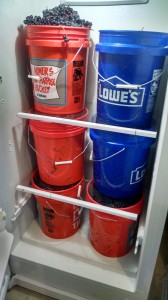
A refrigerator full of wine grapes — this is about half the load of Cab Franc. We dumped these into the cooler and refilled the frig.
So, before we picked the first grapes, I started making a cheat sheet. It went something like this:
First, add sulphur at a rate of 50 parts per million (.33 grams per gallon), which kills off unwanted natural yeasts and protects the must (the mix of juice, skins, seeds, and stems that will turn into wine) during those vulnerable hours before fermentation begins. Next, check the brix, pH and TA (titratable acidity) of the must (add a dozen steps here). Rehydrate the yeast (add a half-dozen steps here). And so on. (Add dozens and dozens of individual steps.) And for all that, I found myself furiously reading the instructions (again) on my lab test equipment to be sure I knew how to test the TA, and reading other literature on hydrating and preparing yeast.
When we arrived back in Fairfax, we started with the easy stuff: the sorting table. We had purchased a folding table, which turned out to be the perfect place for the family and friends to gather around for some work and talk. Kind of like what I imagine a quilting bee was like a century or so ago. We pulled some chairs around the table, and the VG and I, plus daughter Kate and a couple of neighbors, sorted the grapes. That’s easy and straightforward, but it’s also very time consuming.
The fruit was amazing, so we didn’t throw away very much at all. Mostly, we were looking for MOG – matter other than grapes. We found the occasional spider web (with the spider, in most cases, which elicited a few screams), and some extra leaves and such. But the fruit that went into the crusher was just about perfect.
The crusher-destemmer was way more of a machine than we really needed. It crushed the fruit faster than we could drop it in, and we were finished with that part of the process in maybe ten minutes. Honestly, cleaning it took way longer than the actual crushing. But I’m still glad I bought it. More on that in another post.
In the end, the Cab Franc yielded some 20 gallons of must – juice, grape skins, seeds and some stems that fell through the destemmer. As luck would have it, I had a 20 gallon bucket on hand to catch it all. Again, we’re still on the easy part.
I weighed the sulphur (potassium metabisulphite), mixed it with distilled water and added it to the must. And then, I spent hours measuring the pH and TA and brix, deciding whether to adjust the sugar level or acidity (I decided not to), and preparing to pitch the yeast. And in between, I cleaned out the crusher, the extra buckets, and everything else I used in the process. Not to mention sanitizing everything that came into contact with the must.
I have always used potassium metabisulphite for sanitizing, but now, with my own grapes at stake, I worried a bit. I had used sulphites at 50 ppm to protect the must, and the mix for the sanitizing solution was much stronger than 50ppm. So I decided to go with Star San, an acid-based sanitizer that requires no rinsing afterward. Pretty much every bone in my body was calling for sulphur, but I resisted.
It was some day. We were in the vineyard at about 7 a.m., and it was close to 10 before I pitched the yeast, which started the fermentation (Not right away mind you; no, the yeast played with me, waiting days before they actually began to ferment the must).
Much of the time spent that day involved nothing more than anxiety – wanting to get everything just right and worrying that I was getting everything just wrong – but another part of it was the actual physical labor involved. By the time the day was over, I was exhausted, and the memory of hugging the Vineyard Goddess at the end of the harvest was just that – a distant memory.
Well, I suppose in the end, it’s like dating the first girl you had a crush on – the hopes, the anxiety, the desire to get everything just right, the certainty that you have gotten everything totally wrong, and the physical exhaustion that comes from working so hard.
But I’m hoping this crush is like the time I laid eyes on the Vineyard Goddess for the first time. If this crush is as perfect as that one, we’ll have a wine for the ages.
Sampling Wine Across Europe
We’ve visited a lot of wine regions over the past 20 years or so, but as our interest in viticulture and winemaking has grown, we’ve begun looking at vineyards and wineries with new eyes. That was especially the case on our most recent vacation, where we visited Venice, London, and Bordeaux. Especially Bordeaux. But I’ll get to that later.
While we enjoyed the winery visits we made in years past, it was a different kind of enjoyment from today. Then, we would taste wine in
Sonoma or Napa or some other wine valley, and buy a bottle or two to take home. Sometimes we might hire a limo or go in a van or micro bus tour with other couples, and those were great times that I wouldn’t trade away for anything.
Today, though, we are as interested in what goes on behind the scenes – in the vineyard and in the cellar – as we are in tasting the wine. Actually, they’ve become related pursuits. When we visit wineries, ideally we’d like to look at the vines and talk to vineyard managers about the soil, the climate and all of the other things that make their wine special. We want to see the cellar and the barrel rooms (although I sometimes feel that when you’ve seen one barrel room, you’ve seen them all), and we want to talk to the winemaker about the vintages we’re going to taste, the challenges that they faced in each of those years, and the approach they take to making the wine. And then, of course, we want to taste, but only after we know something about the vines and cellar practices.
That’s the ideal; the reality usually falls a bit short. Actually, it usually falls a lot short. Most tasting rooms in the United States are staffed by novices with limited knowledge of the wines they’re pouring, and it’s rare to find a winery where we can see the vineyard and talk to someone who knows anything at all about the vines. Of course, there have been days when we’ve been able to realize that ideal. And a week ago, in Bordeaux, we hit the mother lode.
First things first, though. We had decided to start our trip in Venice, where we thought we’d relax and adjust to European time in a leisurely way. And truthfully, we just love Italy in general and Venice in particular. This trip, we decided to go for a change in scenery by staying in Murano, a small island that is perhaps a 20 minute vaporetto (water bus) ride from Venice.
On our second day, we ventured over to Burano, an island known for lace and, for us, the scene of some of the most memorable meals of our lives. As it happens, Burano is connected by a bridge to another small island – Mazzorbo – and on Mazzorbo, there is a small restaurant and inn with a vineyard. The vineyard is just over two hectares in size, and it is entirely surrounded by medieval walls that were rebuilt in 1727. According to the web site, the vines are mostly ungrafted, which means they are growing on their own roots, rather than on an American rootstock that is immune from phylloxera, the aphid-like insect that nearly destroyed the European wine industry in the 19th century.
Old as the walls are, the vineyard itself was planted just three years ago, the same year that we planted our own small hobby vineyard. So, of course we were interested in comparing notes with the vineyard manager. Alas, this is one of those times where our expectation fell short of reality. We had the opportunity to wander through the vineyard, but unfortunately, the restaurant and tasting room were closed for an event, and most of the folks we hoped to talk to were missing. Well, maybe next time.
But it’s pretty hard to be unhappy in Italy. We had a number of great meals and some lovely wine. And there’s something special about walking around under the Italian sun.
London didn’t afford us any opportunities to visit wineries, but between the British museum, the British Library, Kensington Palace and the wonderful London theater, we had some good meals and good wine. And we did enjoy several wine bars. One was the “Green Man and French Horn,” a bar that specializes (exclusively) in wines from the Loire Valley. I found that surprising. I suspect most people don’t know Loire Valley wines very well, if at all, and I didn’t know much about most of the wines on the list. But there were some familiar wines, especially the Chinon, which are based on Cabernet Franc, and the Viognier. Both grapes, by the way, do exceptionally well in Virginia, and we have both growing in our own vineyard.
Our favorite wine bar, though, was “The Ten Cases,” which serves a dozen or so different wines, but orders just ten cases of each. Once those ten cases are finished, the wine is gone from this bar forever, and ten cases of a different wine are ordered in its place. We loved the food, and loved the wine. If we lived in London’s Convent Garden area, where it’s located, I suspect we would dine there on the order of once a week.
After London, we moved on to Bordeaux, which was something quite special. Our apartment looked out over the ancient city gate, the Porte de Bourgogne, and the Garonne River. Inside, there was a small wine rack on the wall with four bottles of Bordeaux. The information folder explained that some guests arrive too late to be able to purchase wine; in those cases, they should open the bottle of their choice and replace it with another. The bottles weren’t terribly exciting – Bordeaux Superieur, for example – but I’m sure they were fine. As it happened, we didn’t arrive too late to purchase wine of our own, and I opted for an inexpensive St. Emilion to keep handy for a late afternoon- early evening glass on our terrace. I think I might have paid a grand total of 9 Euros for it, and it was delicious.
On our first day, still tired from waking at 3:30 a.m. in London to get to Gatwick for an early flight, we wandered through the town center, and sat down at a small café for some wine and cheese. I believe the wine was a Pauillac, and it set the pattern: we didn’t have one bad glass of wine the entire visit.
But it’s one thing to enjoy a bottle of wine at a restaurant, wine bar or tasting room, and quite another to get outside the city and tour the great wine estates. We did both, and I’ll focus on the estates we visited in my next post.
Natural Wine, part I: Alice Feiring’s “Naked Wine”
Alice Feiring: Naked Wine
One of the most arresting moments in Alice Feiring’s book on natural wine is occasioned by a question she posed to Jacque Neauport, one of the movement’s pioneers, on what motivated him to make wine without sulfur. He is momentarily speechless, 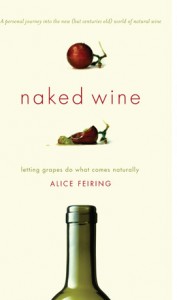 then nearly convulsed with laughter.
then nearly convulsed with laughter.
“Because we were drunkards!” he finally responds, explaining that they hoped that wine without sulfur would allow them to drink heavily and avoid hangovers. Ms. Feiring is clearly shocked. “I had come to the oracle for answers, and all he had for me was a punch line,” she writes.
There’s something disarming about these passages, although I suspect that readers who have been put off by her writing style and dogmatic approach to natural wine will take some pleasure in her discomfort. My reaction was different. I’m not sure I would have had the courage or confidence to retell a story like this, so it made me like her, as well as her book, a good deal more than I had up to that point.
Early on, I wondered if I would be able to recommend Naked Wine, or for that matter, even finish it. Her book is written in the style of a blog, and it is infused with her personality. If you happen to like that personality, you will probably like the book. If you find her style, as a friend of mine did, “annoying,” then you will find much of the book insufferable.
At the end, I’m somewhere in the middle. The book is definitely not for everyone, but for those interested in making an initial foray into the world of natural wine, it’s a pretty good introduction. Continue Reading–>
Every Grape is Different — Notes from a Vineyard Conference
The Virginia Vineyards Association brings together commercial grape growers, hobbyists and others with an interest in viticulture, and its efforts to promote cooperation and the exchange of information is one of the reasons that the Commonwealth’s wine gets better every year. I believe, and I think most of the growers who participated in the association’s technical meeting in Charlottesville last week would agree, that the reputation of Virginia wine is influenced by every bottle that’s sold. If someone has a bad experience the first time they taste a Virginia wine, they may never try another. So all of us have a vested interest in doing what we can to help each other make the best wine possible.
Another reason for the success of the Virginia wine industry is the work that’s being done at Virginia Tech by folks like Tony Wolf, Bruce Zoecklein, and Mizuho Nita, all of whom played major roles at the meeting. Tony Wolf’s book, Wine Grape Production Guide for Eastern North America, has become our bible as we move toward planting a small hobby vineyard, and Mizuho Nita’s blog is the indispensible guide to grape disease management.
However, this was my first encounter with Dr. Zoecklein, and I’m hopeful now that it won’t be my last. Dr. Zoecklein has written the book (actually, at least four books and too many articles to count) on wine chemistry, and he manages to make the chemistry both accessible and practical for people like me. And since this was a class on “Sensory Evaluation for Grape Growers,” he taught the class through the tastes and aromas of seven separate wines, which we tasted blind throughout the class. Continue Reading–>
The Year of the Sorting Table
Following up on my last blog, which concerned Cab Franc, Tim Mondavi, and the 2011 vintage in Virginia, among other things, I just read Emily Pelton’s article on the 2011 harvest in Grape Press, the publication of the Virginia Vineyards Association, and I am somewhat more hopeful about this vintage.
First, some introductions. Emily Pelton is the winemaker extraordinaire at her family’s
vineyard in Nelson County, Veritas Vineyard and Winery. And the Virginia Vineyards Association is the indispensable organization for anyone in the Commonwealth interested in viticulture and winemaking. The November issue of the Grape Press was one of the best I've read. In fact, I think I read every word, from beginning to end, and it was all good.
In any event, I spent part of my last post lamenting the difficult weather conditions, particularly the abundant rain that created all kinds of problems in the vineyard. One of the difficult decisions that winemakers and vineyard managers make as harvest approaches is how willinging they are to gamble on the weather. If rain is in the forecast, do you hold out a little longer, hoping the grapes will achieve the perfect balance of sugar and acidity, or do you pick early, sacrificing a bit of brix for the certainty that you will at least have a harvest? Continue Reading–>
Planning for the Spring Planting
Well, we still haven’t come to terms on the vines, but we’re confident we’ll get there, so we’re turning part of our attention to the work necessary to prepare the vineyard for planting. And believe me, there’s lots to do.
First, the decisions. I say first, because the thinking part comes before the physical labor part. And I’ve learned just enough about vineyard management to know that the thinking part is going to be a lot easier than the physical labor part of this enterprise.
But that’s not to say that the thinking part is easy. Nope, not on your life, Bud. There’s a number of decisions to be made. Such as, which way to orient the rows.
The consensus in the viticultural world appears to be that rows should run as close to north to south as possible, so that the sun falls full force on the eastern side of the canopy in the morning and the western side in the afternoon. There are secondary concerns as well. For example, if your vineyard is on a significant slope, the rows should run perpendicular to the slope, which minimizes erosion. Or, if a north-south rows would be too short to be practical – which is to say, if your vineyard is some kind of long, very narrow rectangle – you can orient in a different direction.
However, secondary considerations always lose to the prime directive, which is that rows should run north to south.
In our case, we are somewhat handicapped because the trees surrounding our hobby vineyard limit sun in the morning. Morning is a critical time. Moisture accumulates during the night, and it’s important that the canopy dry as quickly as possible in the morning. That’s why an eastern aspect – a slope, or even flat land, that opens to the east – is so desirable.
Other forces of nature, wind in particular, also dry out vines, but while the sun is reliable in that it appears every morning, wind can’t be counted on. On the mornings that we’ve woken to a steady breeze, we’ve noticed that everything dries quickly. (We probably noticed that years and years ago, but since it didn’t matter to us until now, we didn’t take much note of it.) So, despite the generally untrustworthy nature of wind, we are now trying to figure out if it tends to blow in a particular direction in our little valley. If so, then perhaps it would pay to forget the conventional wisdom and go with a different approach.
There’s more, of course. I’ll be continuing this discussion for some time to come. Thank God we’re still on the thinking part.
The Agony of Dropping Fruit
This is only a guess, albeit a somewhat educated guess, but I suspect every vineyard worker has the same uneasy, guilty feeling the first time he drops fruit from a vine.
By dropping fruit, I mean walking through the vineyard, from one vine to the next, and cutting off perfectly good clusters of grapes and letting them fall to the ground. It seems wasteful, and when you see a cluster of nearly perfect grapes lying on the ground next to your feet, you feel like a butcher. But you have to remain focused and keep your eye on the prize.
“Think about the wine,” said Julien Durantie, the vineyard manager at DuCard Vineyards. Ah, yes, the wine. Don’t worry about the grapes on the ground that will soon rot and return to the soil to nurture future crops. Think ahead a year or more to the wine that will be made from the fruit that remains.
The idea behind dropping fruit is simple: the vine has only so much energy, and by reducing the number of clusters, you end up with a more concentrated juice and much better, much more intense wine. In a sense, this is a continuation of the process we’ve been engaged in throughout the growing season. Early on, we thinned out the shoots, leaving behind a smaller number of shoots that we hoped would produce high-quality grapes. As we moved through the season, pulling leaves to open up the canopy, we continued to remove suckers, laterals, and extra shoots that would deprive the vine of its vigor.
Removing suckers and thinning shoots was one thing. Clipping off beautiful clusters of berries that were turning into wine grapes, was much harder. I tried to keep my mind focused on the wine.
As was the case in many classes before, I found myself nearly paralyzed at the start, not quite remembering what I had been told, and staring at the vine, afraid to make the first cut. And so, I spent time separating out vines that had become tangled, pulling some laterals (which look like a small, separate leaf system), and considering whether to cut this clump or the next one. And finally, as always, I called Scott Eliff, the vineyard’s owner, or Julien, and begged for help.
We were working just at the onset of veraison, the time in which the berries change color. Here and there, we spotted a few cab franc grapes turning purple, but the vines we actually worked on were Viognier, Virginia’s signature white grape. (Actually, while the Virginia Wine Board has declared Viognier to be the Commonwealth’s Signature Grape, I prefer to think of it as the signature white. Cab Franc and Petit Verdot are my choices for reds.
In any event, a little bit of my heart lay on the ground with each cluster of grapes. And I was only the hired (well, volunteer) help. I can’t imagine how agonizing it is for the owner of the vineyard to drop fruit, knowing he or she is reducing the vineyard’s yield significantly with each clip of the pruning shears.
Fortunately, this is one kind of heartache that can be cured by opening and tasting a bottle of wine that has benefitted from the “Green Harvest” of dropping fruit. Wine is often said to be made in the vineyard, and the best is made by vineyards like DuCard that are willing to sacrifice quantity for quality.
Not just a tasting room: Touring Sonoma’s Wine Valleys
Last week, the UPS truck brought a box of wine from California, reminding me just how late I am in writing something about our tour of Sonoma's Russian River and Dry Creek Valleys. The box contained bottles we had purchased in visits to five separate vineyards, and each told its own story — one of terroir, another of organic viticulture methods, and yet another of vines that were planted in the century before the last one.
It was a wonder that we ended up collecting any of these bottles and their stories. When we first 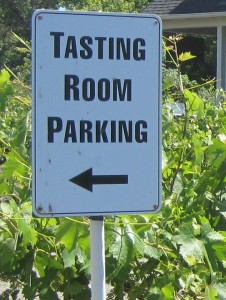 started planning the tour, I had thought we might visit some of the vineyards that make wines I know and like, such as Simi, a Healdsburg-based winery that makes a Cab I enjoy. But we signed up with Valley Wine Tours, and in the weeks leading up to the trip, I exchanged a series of emails with our tour guide, Bob Howells, who helped me think through the options. "We can go there," he said about one of my choices. "But it's just a tasting room."
started planning the tour, I had thought we might visit some of the vineyards that make wines I know and like, such as Simi, a Healdsburg-based winery that makes a Cab I enjoy. But we signed up with Valley Wine Tours, and in the weeks leading up to the trip, I exchanged a series of emails with our tour guide, Bob Howells, who helped me think through the options. "We can go there," he said about one of my choices. "But it's just a tasting room."
That made sense. We were looking for something more than another tasting room experience. As we get closer to planting vines (beyond the 14 experimental vines we are tending on two different properties), our primary focus is on educational opportunies.
Martinelli converted this lovely barn into a tasting room.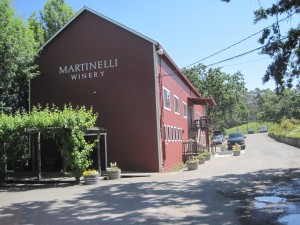
What we were looking for on this trip were wineries where we'd have an opportunity to chat with winemakers, vineyard managers and owners. Until my email exchange with Bob, it hadn't occured to me that we wouldn't get that at the larger wineries that ship back to the east coast.
After providing that bit of counsel, Bob was extremely helpful in planning our itinerary. I was particularly interested in three Sonoma AVAs — the Alexander Valley, Dry Creek Valley and the Russian River Valley — and he provided a list of six vineyards for each. After a couple of hours of research at Total Wines in Chantilly, I discovered that the wines from these vineyards were generally not available in stores on the east coast.
So far, so good, then. We would visit wineries that we would otherwise never experience. We decided to eliminate Alexander Valley, even though it is a great terroir for Cabernet, my favorite grape varietal. We couldn't do all three, and Bob said it would be easier to get the experience we were looking for in the other two AVAs. And he promised we would have an opportunity to discuss wine with knowledgable people who are passionate about what they do.
We visted five wineries that day: Martinelli Winery, Inman Family Wines, Battaglini Estate Winery, Talty Vineyards and Winery, and Truett-Hurst Vineyards. We loved them all, each for different reasons and each because it contributed in a different way to our education. Martinelli, for example — perhaps the largest of the vineyards we visited — was all about terroir. The Martinelli family has more than 300 acres planted, but only 15 percent goes to their own labels, while the rest is sold to other wineries. We tasted Chardonnays from three separate vineyards that are part of their property, and each was distinctly different. The Woolsey Road vineyard, for example, is a packed-clay soil, and the wine had pronounced mineral notes, while the Three Sisters vineyard, more of a sandy loam soil, featured a much softer, more buttery Chard.
While I liked all five vineyards, I'll focus on two here, Inman and Battaglini. Both were extemely generous with their time, and both offered the kind of unique educational experience we were seeking.
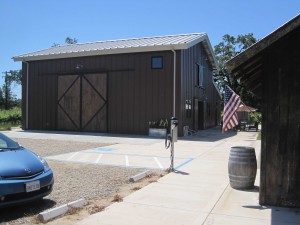
- Inman Family Wines is a small, family-run vineyard and winery focused on the production of elegant Pinot Noirs.
We bumped into Kathleen Inman even before we got into the winery. She was busy arranging outdoor furniture to prepare for the day's visitors, but she took out an hour of her time out to talk to us about the vineyard. Kathleen is big into organic viticulture, and she discussed the organic sprays they use, which are not as easy to find as the non-organic variety and significantly more expensive. Some of the vineyard consultants I've talked to back on the east coast are dismissive of organic sprays, but Kathleen is getting great results.
We spent some time talking about canopy management, including her determination to remove all lateral shoots from the vines. Laterals are extraneous shoots situatued just above a leaf, which are in a sense "a shoot coming out ot a shoot." The leaf is valuable, since it contributes to photosynthesis. The lateral simply drains energy from the vine. In addition, removing laterals provides a bigger bang for the buck when thinning the canopy. Pulling a lateral removes three or more leaves at once, compared to the removal of a single leaf. Kathleen also showed us the equipment she uses to make "compost tea," a liquid brewed from compost that can be used to add nutriets to the soil or to protect the canopy from disease.
One surprise: To the maximum extent possible, Inman uses natural yeasts, the yeasts that are present on the skin of the grapes. Many, perhaps most winemakers, prefer to kill the natural yeast with potassium metabisulphite, and then add a specific commerically-made yeast to start the fermentation. I don't think I would have the courage to rely on natural yeasts, but after tasting the wine, I don't see how anyone can argue with Kathleen's methods.
And yes, we finally did get around to tasting. We were thrilled in particular with the Pinots, which were lush and balanced with nice acidity — perfect for food. Pinot Noir is one of the most difficult grapes to grow, and Kathleen's passion for Pinot Noir is clearly evident in her wines. In addition to some Chardonnay, we purchased the 2007 Thorn Ridge Pinot Noir. While I don't pretend to have the world's most sophisticated sense of smell or taste, I picked up blackberry and dark fruit on the nose, and tasted dark cherry in particular on the palate. A fabulous Pinot.
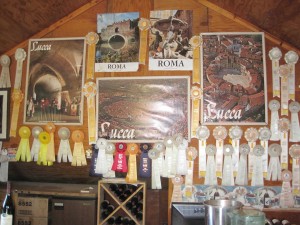
- Joe Battaglini's tasting room looks like a page out of a history book. Nothing fancy, but the wine and Joe's company are what counts here.
At Battaglini, we tasted Zinfidels that gave new meaning to the words, "old vine." Owner Joe Battaglini, who hails originally from Luca, Italy, purchased 30 acres in the Russian River valley in 1998, inheriting vines that are now 126 years old.
This is a one-of-a-kind operation. The tasting room is a small corner of what appears to be an old shed, decked out with pictures of Luca, Rome and other Italian cities, plus the many ribbons he's won in wine competitions over the years. After tasting, and before lunch, which we ate at a shaded table outside the tasting room, Joe took us on a tour of the vineyard. The old vines produce very little in the way of grapes, and a corporate-owned winery would have torn them out years ago in favor of young, higher-productivity vines. Joe dotes on his old vines, even giving them names. One, for example, looks like a huge chair, and so Joe named it "the throne."
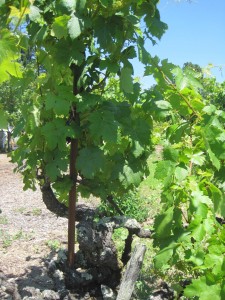 The first thing you notice about the old vines is the lack of trellising. "That's how it was done back then, and how it was when I bought the vineyard," he said. "I didn't want to change anything."
The first thing you notice about the old vines is the lack of trellising. "That's how it was done back then, and how it was when I bought the vineyard," he said. "I didn't want to change anything."
Of course, some things are changing. A modern tasting room is under construction. I suppose it will serve the needs of the winery better, but I can't help but think it will lack the charm of the little shed with the bar and the photos, which remains locked until visitors show up and Joe comes out to greet them. The winery itself is also modern, and after we finished eating the picnic lunch Bob had brought for us, Joe popped out again and offered us a tour.
At the winery, you can choose from 28 Zinfandels, six Petite Sirahs and four Chardonnays. Not a bad selection. We bought a half dozen Zins, and have already enjoyed one. They're ageworthy, but I doubt they'll get that opportunity.
Me, Joe and the Vineyard Goddess, after a tasting.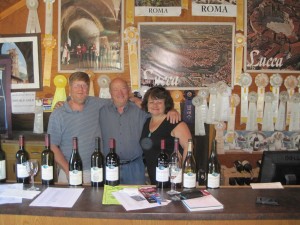
Finally, returning to the sub-theme of this post, the afternoon before this tour, we passed by the Benziger Family Winery after a visit to the Jack London state park (which includes a great museum, with lots of history related to this uniquely American writer) and decided to stop in. We've been there once before, and enjoyed it thoroughly. On our last visit, we took advantage of the tram tour, which shuttles you through the vineyard and on to the crush pad, the fermentation facility and the barrel caves. If you don't take the tram tour, you can still wander through the biodynamic vineyard exhibit, a garden-like setting that explains the vinyeard's green approach to growing grapes.
This time, we arrived shortly before closing, and had time for a tasting only. It was $10 (perhaps a bit steep?), but the wines were good and the setting quite pleasant. Our server was articulate and friendly, and I asked him how long he had been working at Benziger. Thirteen weeks, he said, which explained why he didn't know much more than might have been contained on a script. He wasn't bad, by any means, just not knowledgeable enough to go beyond some basics on each of the wines.
Benziger: It's hard to imagine a more beautiful vineyard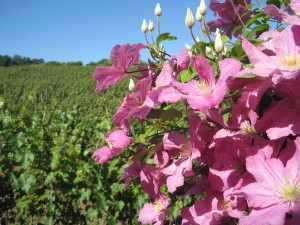
Which made me realize, a day before we began our tour, how right Bob had been in steering me away from a winery I loved that would have been "just a tasting room," in favor of experiences I'll remember for the rest of my life.

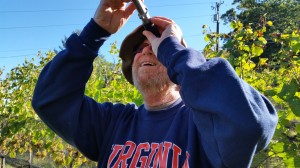
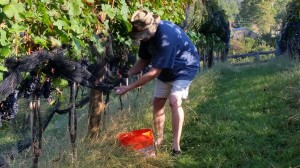
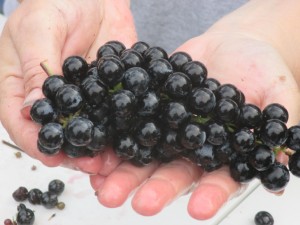
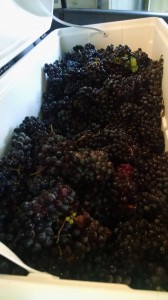
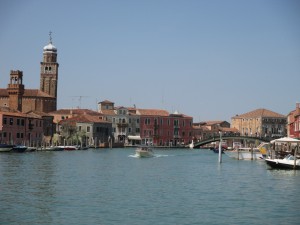
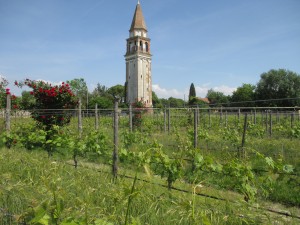
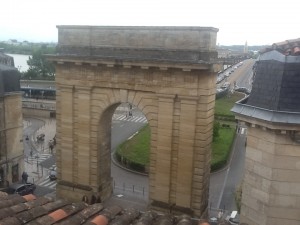

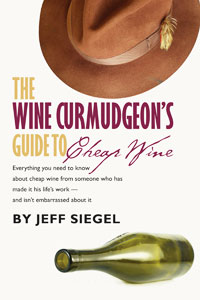

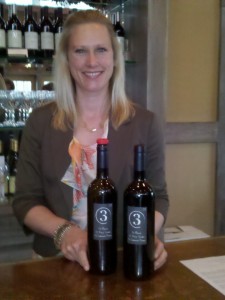
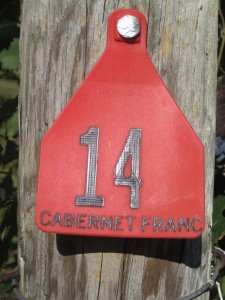
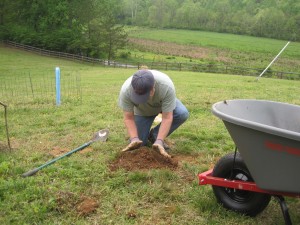
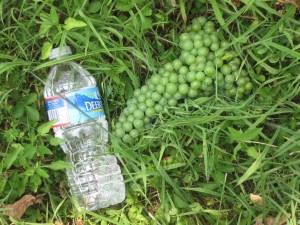
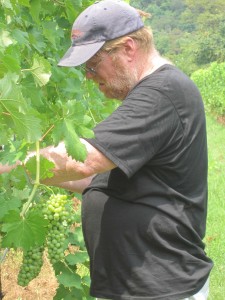
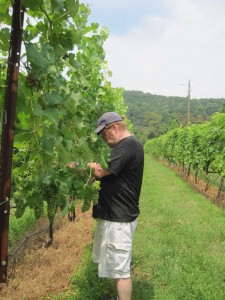
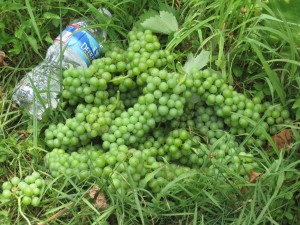
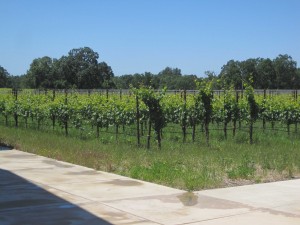
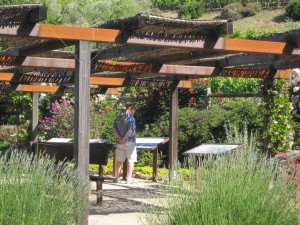


Recent Comments